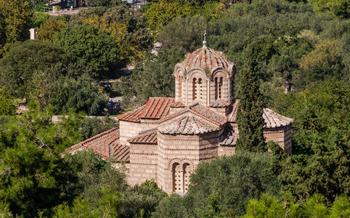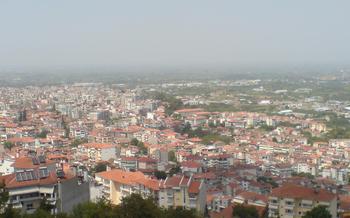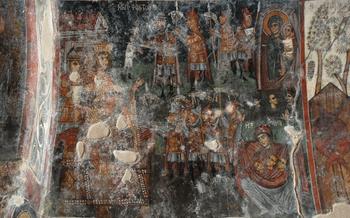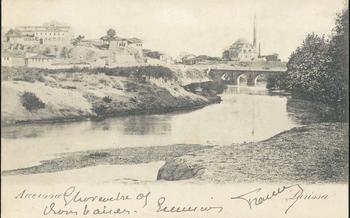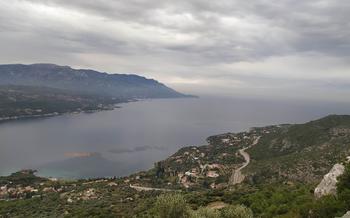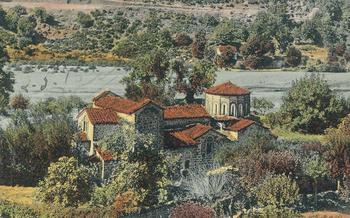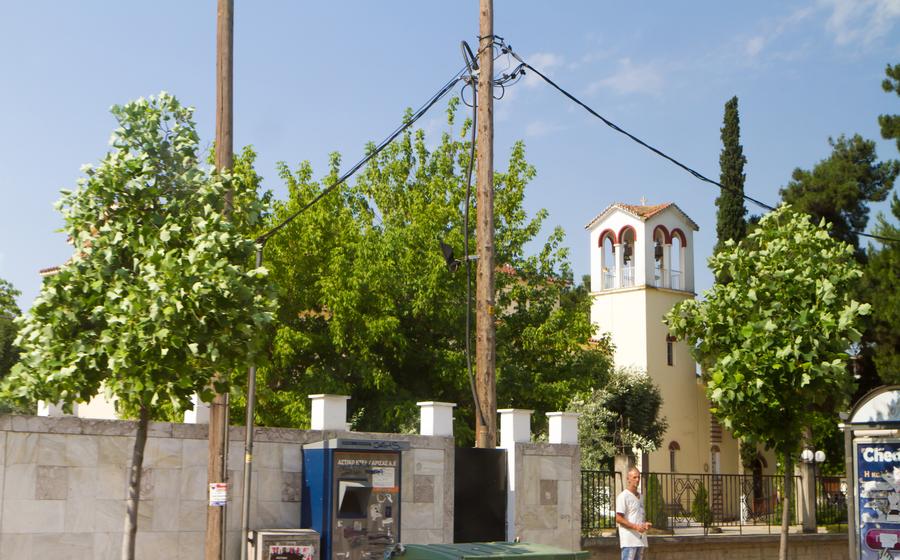
Saint Achellios Cathedral
- Historical Significance
- Architectural Marvel
- Interior Beauty
- Religious Significance
- Cultural Importance
- Visiting Tips
- Photography Opportunities
- Historical Context
- Restoration and Preservation
- Local Legends and Folklore
- Religious Ceremonies and Festivals
- Local Cuisine and Hospitality
- Nearby Attractions:
- Sustainable Tourism
- Insider Tip:
Historical Significance
The Saint Achellios Cathedral, a majestic edifice steeped in religious significance, stands as a testament to the rich history of Larissa. Dedicated to Saint Achellios, the patron saint of the city, the cathedral holds a prominent place in the hearts of the local Orthodox Christian community. Its construction, dating back to the 10th century, reflects the deep-rooted faith and devotion of the people of Larissa. Over the centuries, the cathedral has undergone several renovations and expansions, each contributing to its architectural grandeur and enhancing its status as a beloved landmark. Its intricate Byzantine design, adorned with exquisite mosaics and frescoes, narrates the stories of saints and biblical events, captivating visitors with its artistic and spiritual allure.
Architectural Marvel
The Saint Achellios Cathedral is a testament to the exquisite Byzantine architectural style, showcasing intricate details and symbolic motifs that captivate the eye. Its exterior façade is adorned with intricate carvings, delicate stonework, and vibrant mosaics depicting biblical scenes and religious figures. The majestic dome, a hallmark of Byzantine architecture, crowns the cathedral, adding to its grandeur and visual impact.
Inside, the cathedral's awe-inspiring interior features elaborate frescoes and mosaics that narrate biblical stories and depict saints and angels. The iconostasis, a beautifully crafted screen that separates the sanctuary from the nave, is a masterpiece of Byzantine art, adorned with intricate iconography and gold leaf. The altar area, with its gleaming gold accents and sacred artifacts, exudes an air of reverence and spirituality.
The cathedral's construction involved the use of fine materials, including marble, stone, and mosaics. The skillful blending of these materials creates a harmonious and visually striking effect. The play of light and shadow within the cathedral's interior highlights the architectural details and enhances the sense of wonder and awe.
One distinctive feature of the Saint Achellios Cathedral is its unique blend of Byzantine and Ottoman architectural elements. The cathedral's construction during the Ottoman period resulted in the incorporation of certain Ottoman influences, such as the use of pointed arches and intricate tilework. This fusion of architectural styles adds to the cathedral's charm and historical significance.
Interior Beauty
The interior of the Saint Achellios Cathedral is a testament to the exquisite craftsmanship and artistry that went into its construction. Elaborate frescoes, mosaics, and iconography adorn the walls and ceilings, creating a breathtaking visual spectacle. The iconostasis, a wall of icons separating the nave from the sanctuary, is a particularly stunning feature, adorned with intricate carvings and gold leaf. The altar area, with its marble altar table and ornate candlesticks, exudes a sense of reverence and sanctity. Notable religious artifacts and relics, such as the silver reliquary of Saint Achellios, are housed within the cathedral, adding to its religious significance.
Religious Significance
The Saint Achellios Cathedral holds immense religious significance as a center of worship and pilgrimage for Orthodox Christians. Dedicated to Saint Achellios, the patron saint of Larissa, the cathedral is deeply revered by the local community and visitors alike. Saint Achellios is believed to have been martyred on the site where the cathedral now stands, and his relics are enshrined within the church. Throughout the year, the cathedral hosts numerous religious ceremonies, festivals, and events that draw faithful from across the region. The most significant celebration is the feast day of Saint Achellios, observed on May 15th, when thousands of pilgrims flock to the cathedral to pay homage to the saint and seek his blessings. The cathedral exudes a palpable spiritual atmosphere, inviting visitors to immerse themselves in the sacred traditions and beliefs of the Orthodox Christian faith.
Cultural Importance
The Saint Achellios Cathedral holds immense cultural significance as a symbol of Greek Orthodox heritage. It stands as a testament to the deep-rooted faith and traditions of the Greek Orthodox Church, which has played a pivotal role in shaping the cultural identity of Larissa and the surrounding region. The cathedral has been a focal point for religious and cultural gatherings throughout history, hosting significant events such as weddings, baptisms, and religious festivals. Over centuries, the cathedral has become an integral part of the local community, deeply woven into the fabric of everyday life and customs. Its presence has influenced the development of local traditions, rituals, and practices, which are still observed and celebrated by the people of Larissa. Furthermore, the cathedral's architectural and artistic features have contributed to the cultural landscape of Greece, showcasing the country's rich heritage and serving as a source of inspiration for future generations.
Visiting Tips
Planning a visit to the Saint Achellios Cathedral is a rewarding experience. The cathedral is open to visitors daily, with extended hours during major religious holidays. Admission is free of charge, and there is no dress code, although modest attire is recommended as a sign of respect.
To fully appreciate the cathedral's beauty, aim to visit on a clear day when the natural light illuminates the intricate details of the exterior and interior. Avoid visiting during peak tourist season (July-August) to escape the crowds and enjoy a more intimate experience.
Combine your visit with other nearby attractions such as the Larissa Archaeological Museum, the Old Town, and the Alkazar Park to create a comprehensive cultural and historical itinerary.
Remember to be respectful of the religious significance of the cathedral by maintaining silence and refraining from taking photographs during worship services.
Photography Opportunities
The Saint Achellios Cathedral offers a wealth of stunning photo opportunities for visitors with a keen eye for capturing architectural beauty. Stand in awe before the cathedral's imposing façade, adorned with intricate stone carvings and delicate mosaics. Capture the grandeur of the interior, with its soaring arches, elaborate frescoes, and shimmering chandeliers. Don't miss the opportunity to photograph the intricate details of the iconostasis, the altar area, and the many religious artifacts housed within the cathedral.
To capture the full majesty of the cathedral's exterior, position yourself across the square or find a higher vantage point to encompass its towering presence. Inside, utilize a wide-angle lens to capture the expansive interior and the interplay of light and shadow. For close-up shots of the frescoes, mosaics, and iconography, a tripod will ensure sharp and steady images.
Whether you're an amateur photographer or a seasoned pro, the Saint Achellios Cathedral is a treasure trove of visual delights, waiting to be captured and shared with the world.
Historical Context
The construction of the Saint Achellios Cathedral was deeply rooted in the historical context of Larissa and the surrounding region. During the Byzantine period, Larissa flourished as a prominent city within the Byzantine Empire. The decision to build a grand cathedral in Larissa reflected the city's growing importance as a religious and cultural center. The cathedral's location, in the heart of the city, symbolized the central role that Christianity played in the lives of the local population.
The construction of the cathedral was also influenced by the political and religious climate of the time. The Byzantine Empire, under the reign of Emperor Justinian I, embarked on an ambitious building program, constructing numerous churches and cathedrals throughout the empire. The Saint Achellios Cathedral was part of this larger imperial plan to strengthen the Byzantine identity and promote Orthodox Christianity.
Restoration and Preservation
The Saint Achellios Cathedral has undergone several restoration and preservation efforts over the years to maintain its historical integrity. One notable project was undertaken in the early 20th century, when extensive repairs were made to the cathedral's exterior and interior. These renovations included reinforcing the structure, restoring the intricate frescoes and mosaics, and replacing damaged marble tiles.
In recent years, the cathedral has faced new challenges due to its age and exposure to the elements. In response, a comprehensive restoration project was initiated in 2015, focusing on the cathedral's exterior. This project involved cleaning and repairing the stonework, restoring the stained glass windows, and repointing the mortar joints. The project was successfully completed in 2018, and the cathedral now stands as a testament to the enduring spirit of Greek Orthodox heritage.
Preserving the Saint Achellios Cathedral is of paramount importance, as it represents a significant part of Larissa's cultural and religious identity. The ongoing efforts to maintain and restore the cathedral ensure that future generations can continue to appreciate its architectural beauty and historical significance.
Local Legends and Folklore
The Saint Achellios Cathedral is steeped in local legends and folklore that have been passed down through generations. One popular legend tells the story of a young shepherd named Achellios who lived in Larissa during the early Christian era. Achellios was known for his kind heart and generosity, often sharing his food and shelter with those in need. One day, while tending his sheep in the hills, Achellios encountered a group of travelers who were lost and weary. He welcomed them into his humble home and offered them food and shelter.
Among the travelers was a wise old man who, in gratitude for Achellios's kindness, revealed that he was an angel sent by God. The angel told Achellios that he was destined to become a great saint and that he should build a church on the spot where they had met. Achellios followed the angel's instructions and built the church, which became known as the Saint Achellios Cathedral.
Another legend associated with the cathedral tells the story of a miraculous icon of the Virgin Mary that was found in the church's foundations during its construction. The icon is said to have been painted by Saint Luke the Evangelist and is believed to possess miraculous powers. Many pilgrims visit the cathedral to pray before the icon and seek its blessings.
These legends and stories have helped to shape the local identity and cultural heritage of Larissa. They add an extra layer of charm and mystique to the Saint Achellios Cathedral, making it a place of not only religious but also cultural significance.
Religious Ceremonies and Festivals
The Saint Achellios Cathedral is a hub of religious activity throughout the year, hosting various ceremonies, festivals, and events that draw worshippers and visitors from near and far. One of the most significant events is the annual celebration of Saint Achellios' feast day on 15 November. During this time, the cathedral becomes the center of a grand religious festival that attracts thousands of pilgrims. The festivities include solemn processions, special liturgies, and prayers, culminating in a vibrant celebration of the patron saint's life and legacy.
Another notable event is the Holy Week leading up to Easter, where the cathedral holds special services and rituals that commemorate the Passion, Death, and Resurrection of Jesus Christ. These services are characterized by elaborate processions, chanting, and the reading of scriptures, creating a deeply spiritual and moving atmosphere within the cathedral.
Throughout the year, the cathedral also hosts numerous other religious ceremonies, such as baptisms, weddings, and memorial services, each holding a special significance in the lives of the local community. Visitors are welcome to attend these ceremonies, with due respect and adherence to local customs and traditions, to experience the vibrant religious heritage of Larissa and the Orthodox Christian faith.
Local Cuisine and Hospitality
Larissa offers visitors a tantalizing array of culinary delights that reflect the rich flavors and traditions of Greek cuisine. From mouthwatering souvlaki and gyros to fresh seafood and succulent lamb dishes, there's something to satisfy every palate. Don't miss the opportunity to sample the local delicacies, such as the flavorful "tiropita" (cheese pie) or the sweet "loukoumades" (honey-drizzled doughnuts).
Immerse yourself in the warm hospitality of the local people, who are known for their friendly nature and eagerness to share their culture with visitors. Whether you're dining at a traditional Greek taverna or simply strolling through the city streets, you'll encounter the genuine warmth and welcoming spirit of the locals.
To fully experience the local cuisine, venture beyond the tourist hotspots and explore the hidden culinary gems that Larissa has to offer. Ask the locals for recommendations on the best places to sample authentic Greek dishes, and be prepared for a gastronomic journey that will leave your taste buds tingling.
Insider Tip: For a truly unique dining experience, head to the picturesque alleys of the Old Town, where you'll find charming tavernas serving traditional Greek dishes with a modern twist. Enjoy a leisurely meal while soaking in the vibrant atmosphere and the stunning views of the city.
Nearby Attractions:
Beyond the spiritual and architectural wonders of the Saint Achellios Cathedral, Larissa offers a wealth of nearby attractions to explore. Embark on a historical journey at the Larissa Archaeological Museum, showcasing artifacts from the city's ancient past. Immerse yourself in the natural beauty of the Alkazar Park, a sprawling green oasis with walking trails and a picturesque lake. For a glimpse into traditional Greek culture, visit the Larissa Central Market, a vibrant hub of local vendors selling fresh produce, handmade crafts, and regional delicacies.
History buffs will delight in exploring the ancient ruins of the Larissa Castle, a testament to the city's rich past. Art enthusiasts can admire the contemporary masterpieces at the Municipal Art Gallery of Larissa. Nature lovers can escape to the scenic Nikaia Lake, a tranquil haven with stunning views of the surrounding mountains.
Combine your visit to the Saint Achellios Cathedral with these nearby attractions to create a comprehensive and enriching experience in Larissa. Whether you seek historical wonders, cultural immersion, or natural beauty, Larissa has something to offer every traveler.
Sustainable Tourism
When exploring the Saint Achellios Cathedral and Larissa, embracing sustainable tourism practices is crucial for preserving the city's cultural heritage while minimizing environmental impact. Visitors should prioritize walking or using public transportation instead of driving to reduce carbon emissions. Supporting local businesses that champion sustainability, such as restaurants using locally sourced ingredients or shops selling eco-friendly products, is another way to contribute to the local economy and promote responsible tourism. Additionally, being mindful of waste and properly disposing of it ensures that the city's natural beauty is preserved for future generations. By embracing these sustainable practices, visitors can contribute to the well-being of Larissa and its people while enjoying their journey responsibly.
Insider Tip:
For an unforgettable experience, plan your visit to coincide with the annual feast day of Saint Achellios, celebrated on November 13th. During this special day, the cathedral comes alive with vibrant celebrations, including a solemn procession carrying the icon of Saint Achellios through the streets of Larissa. Participate in the festivities, witness the devotion of the local community, and immerse yourself in the rich traditions of Greek Orthodox culture. For more information on the feast day and other events, visit the official website of the Larissa Metropolis or inquire at the cathedral itself.
